Welcome to the website of Skin @ School
Aim
The aim of Skin at School was to develop educational materials for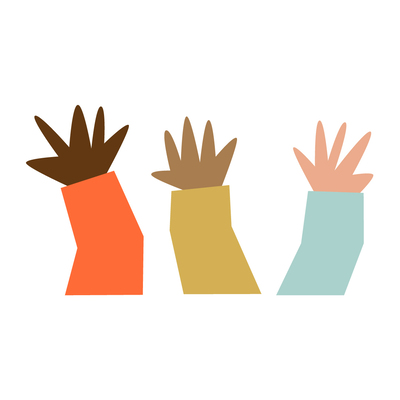 children in The Netherlands aged 4 to 12 fostering knowledge, understanding, skills, and attitudes about their own and other’s skin. To empower children to prevent health risks and enhance their well-being and resilience.
children in The Netherlands aged 4 to 12 fostering knowledge, understanding, skills, and attitudes about their own and other’s skin. To empower children to prevent health risks and enhance their well-being and resilience.
Background
Skin complaints are often underestimated, impacting the quality of life for individuals with chronic conditions, and contributing to significant bullying effects on children. Parents of children with skin conditions face challenges discussing these issues at school, despite the critical importance of skincare and prevention to combat skin cancer. Moreover, misinformation about skincare circulates on social media.
Educational materials
Therefore, healthcare professionals, educational experts, and patient representatives collaborated to determine learning objectives, curriculum topics, and assignment designs.
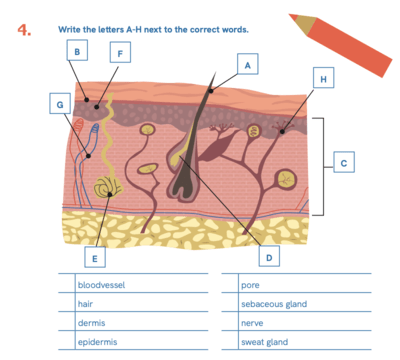
The curriculum was carefully crafted to be substantively correct, fitting into the educational context and being appropriate for patient representatives. A children’s council provided advice. The curriculum, comprising five lessons tailored to specific age groups, covers skin basics, skincare, skin color, temporary and long-lasting skin problems, sun protection, assessing reliable information, acceptance and well-being.
With the teaching package Skin at School, students develop their knowledge, understanding, skills and attitude regarding their own skin and that of other students, enabling them to prevent health risks and increase their own well-being and resilience. The curriculum was developed by Huid Nederland (Dutch Skin Coalition), the umbrella organization for people with skin conditions.
Students learn:
- About the structure and function of the skin
- About similarities and differences between people's skin
- About the importance of caring for the skin
- About temporary and permanent skin conditions and their consequences and
- Conscious and critical handling of information on the Internet
Prototype
Skin at school has been successfully developed, implemented and positively assessed in The Netherlands. All educational materials are free to download in Dutch from the website. Part of the material is translated into English as a prototype to share and to be viewed through this website. With this prototype you can get an impression of the different lessons, the topics and the type of assignments. Most of the lessons can be used in various countries (when they speak English). but some assignments have not yet been adapted because, for example, no suitable book, song or video was available.
Experiences of teachers, parents and patient representatives:
Teacher: ‘I myself have skin problems/a chronic skin condition and one of the students had a chronic skin condition, which allowed us to explain together what it does to your skin and your life if you have a skin condition.’
Teacher: ‘Because I think it is very important that children learn about their skin and the different skin types. In addition, it is important that they learn, especially in primary school, that protecting the skin and common home problems can also occur and how annoying that can sometimes be.’
Parent: ‘Thank you for this interesting material! My child was anxious to tell about his eczema, but during the lessons it turned out he was not the only one in his class!’
Teacher: ‘Children think it is boring to talk about skin, but you have included social media. This makes it more interesting’
Patient representative: ‘Every child needs to identify with a hero in a book, you guys gave some great tips!’
Patient representative: ‘I wish I had these materials when I was a child!’
Publications
Publications
Results of the Skin at School project were published in the Journal of Dermatological Nursing (2024, Vol. 23, No. 4). Link to the journal with the publication
Also three e-posters were presented at the World Congres of Rare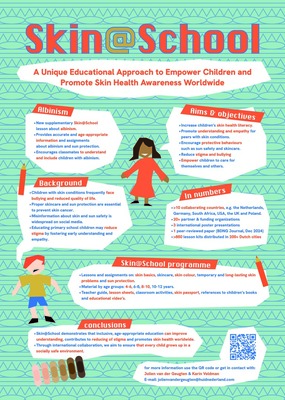 Skin Diseases (Paris, 2024) and the EADV Conference in Amsterdam and Paris (2024, 2025). In April 2025, Karin Veldman gave a presentation about Skin @ School at the Global Skin Conference in Prague. During the World Forum on Skin Cancer in Persons with Albinism in Cape Town in October, a poster on the Skin@School albinism lesson will be presented.
Skin Diseases (Paris, 2024) and the EADV Conference in Amsterdam and Paris (2024, 2025). In April 2025, Karin Veldman gave a presentation about Skin @ School at the Global Skin Conference in Prague. During the World Forum on Skin Cancer in Persons with Albinism in Cape Town in October, a poster on the Skin@School albinism lesson will be presented.
Poster Skin@School Cape Town 2025
Examples of the materials:
Working sheet ichthyosis English (8-12 years)
Working sheet ichthyosis French (8-12 years)
Working sheet ichthyosis Polish (8-12 years)

Skin @ School playlist on YouTube

EADV Guest Lectures Dermatologists 2024
Dermatologists brought national attention in The Netherlands to skin health and the impact of chronic skin conditions on children in connection with the EADV Congress in Amsterdam in September-December 2024. To achieve this, 9 dermatologists, along with a patient advocate (someone with a skin condition), delivered 20 guest lectures at elementary schools across 9 provinces in The Netherlands.
Objectives of the guest lecture:
- Increased knowledge about one’s own skin and that of others.
- Increased knowledge about a (pre-determined) chronic skin condition and its impact.
- Discussed (the impact of) prejudices and how others interact with people who have a chronic skin condition.
Based on the existing "Skin at School" educational material, four versions of the EADV guest lecture were developed for different age groups: group 1/2 (ages 4–6), group 3/4 (ages 6–8), group 5/6 (ages 8–10), and group 7/8 (ages 10–12). The lessons for the upper grades lasted approximately 60 minutes, while those for the lower grades lasted 45–50 minutes. It was important that various teaching methods were used during the lessons to keep the students engaged and to achieve the lesson's objectives.
If dermatologists and patient advocates had not yet been acquainted, they spoke by phone before the guest lecture to introduce themselves, discuss the structure of the guest lecture, and ensure that the patient advocate could identify any topics they preferred not to discuss. After the lesson, they both filled out an evaluation form about their experiences with the guest lecture.
Webinar: Presentation Skin@School programme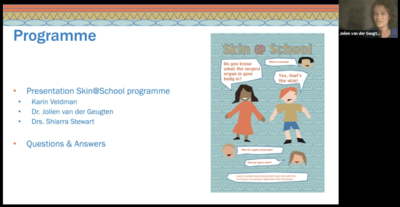 When you want to watch the video of the webinar we presented on November 17th 2025, please fill out this form, and we will send you the link for the video.
When you want to watch the video of the webinar we presented on November 17th 2025, please fill out this form, and we will send you the link for the video.
Yes, I want to see the video
English Prototype Skin@School programme
As mentioned in the video, we have an English Prototype Skin@School programme.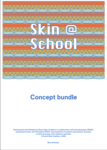 When you wish to receive access to a pdf of this Teacher's manual, please fill out this form, and we will send you a download link.
When you wish to receive access to a pdf of this Teacher's manual, please fill out this form, and we will send you a download link.
Yes, I want to receive the English Prototype Skin@School programme
Contact
Karin Veldman (namdlevnirak@huidnederland.com)
Jolien van der Geugten (netguegrednavneiloj@huidnederland.com)
Skin at School was translated with a grant from Global Skin and support from the Irish Skin Foundation.